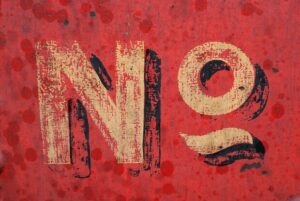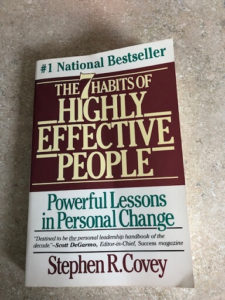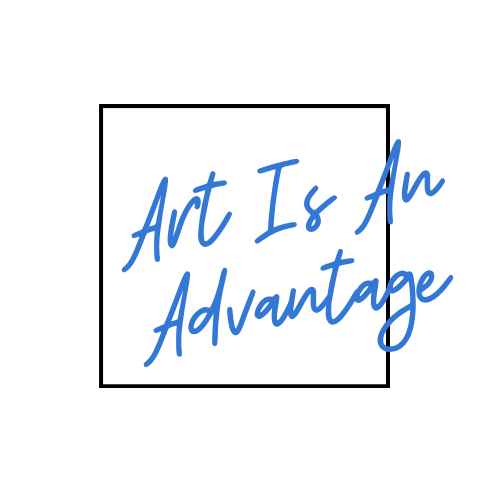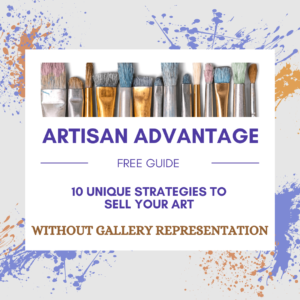by Becky Sciullo | May 26, 2021 | Planning
Recently, a venue approached artist Robert Yonke to have a show later this year. It’s always exciting when a gallery offers an artist a solo exhibition opportunity, and a first assumption is usually of course. Yet, after reviewing the calendar and his current inventory, we decided to pass.
Why would any artist turn down an opportunity for a live in-person solo show after the year we just had?
The truth is, he sold a good bit of work throughout 2020 into this year, and there wasn’t enough time for him to build up a quality body of work to fill the space in time. As an artist that does not work well under pressure, it could have been counterproductive for business this year. So, we asked to schedule it for a later date, and the gallery thankfully accepted our request.
The moral of the story.
 Sometimes you have to say no. And, it is perfectly Ok. When presented with a chance to show work, it’s easy to want to jump right at the opportunity. But, you have to consider the long game, your current goals, and whether or not it will work in the overall big picture of your business.
Sometimes you have to say no. And, it is perfectly Ok. When presented with a chance to show work, it’s easy to want to jump right at the opportunity. But, you have to consider the long game, your current goals, and whether or not it will work in the overall big picture of your business.
A Shameless Plug
I’m proud to say that because we have relied heavily on a consistent art marketing system, he sold art during the pandemic without missing too much of a beat – even though Covid canceled his largest in-person biggest selling event of the year. Going into the pandemic with the system already in place made a big difference for him.
When Does it Make Sense to Say No?
There are times when you should say no in your art business. Here are some ideas as to when this might make sense for you:
When you need to reduce your stress level.
If you feel overwhelmed and overcommitted, you might consider a pause on all new activities and commitments until you can assess your situation and figure out which activities and events should take precedence. Your decision does not have to be final, and you can consider a temporary “no,” as with Robert’s show.
When it Disrupts a Routine that is Working for You
If you have found a routine that is working and bringing you results, you might want to say “no” if the new activity will disrupt what you are currently doing. You can say yes when you can figure out a way to add the commitment alongside your successful routine.
When You Don’t Have Time To Prepare
While perfection can be the enemy of progress, you also don’t want to be woefully underprepared for an opportunity. Take a good look at your calendar and timeline before committing to a new activity. The worst thing would be to be unprepared and make a poor showing.
When It’s Not a Good Fit
Sometimes opportunities present that are not a good fit for your work or your business goals. Having a solid vision of where you want your business to go will help you identify whether an opportunity is one that you should take.
Your time is valuable! This post isn’t to encourage you to say no but rather to be discerning and thoughtful about how you move forward in your business. And then, you are able to say yes confidently when the time is right.
Share Your Story
Do you have an example of a time when it made sense for you to say no? I’d love to hear about it. Please send me a note at becky@artisan-advantage.com.
Photo by Gemma Evans on Unsplash
by Rebecca Sciullo | Feb 21, 2019 | Artisan Advantage Book Club, Learning, Productivity, Resources

If you’re reading through the Artisan Advantage Book Club pick for February, The 7 Habits of Highly Effective People, and made it through the first three habits, you’ve learned about the importance of Private Victory. Private Victory simply means mastery of self – taking responsibility for yourself, identifying your mission and then doing the things you need to do to live it out. The first three habits are ones that will serve you well in all areas of your life, including your art business.
Consider how each habit can apply to your creative venture.
Be Proactive
I often hear artists speak negatively about their ability to sell and run their art business. Can you think of times that you might do this? Can you make a conscious effort to be more proactive in how you talk to yourself? Are there potential roadblocks that you might come across in the future that you can deal with proactively instead of reactively?
Begin with the End in Mind
Whether working with a group or an individual artist, one of the first things I ask them to do is to write out their business vision. This Habit takes it a step further, asking you to write your life mission. Can you add some time to your routine to start working on your personal mission statement? Then, you can write or revisit your business vision, ensuring that it is congruent with your mission. The mission and vision will serve as the guide for your art business.
Put First Things First
This is simply figuring out what activities take priority in your business and then executing them. Which activities need to take top priority in your art business?
I hope you are finding the book beneficial. Please share your thoughts with me at becky@artisan-advantage.com.
Photo by Xan Griffin on Unsplash
by Rebecca Sciullo | Jan 28, 2019 | Artisan Advantage Book Club, Learning, Productivity, Resources
The Artisan Advantage Book Club selection for February is Stephen R. Covey’s The 7 Habits of Highly Effective People®
 This book was published in 1989 and you may very well have read it. This photo shows my copy, which I’ve had since around 1991.
This book was published in 1989 and you may very well have read it. This photo shows my copy, which I’ve had since around 1991.
Why not pick a “new” book?
You can read this book more than once. It packs a lot in, and you can relate to the information in different ways over time. In fact, there is an entire company devoted to teaching people how to use the lessons in the book. Whether you’ve read it or not, it is a great place to start to set the foundation for a productive year in your art business.
Powerful lessons in personal change.
Stephen R. Covey’s book, The 7 Habits of Highly Effective People®, continues to be a best seller for the simple reason that it ignores trends and pop psychology and focuses on timeless principles of fairness, integrity, honesty, and human dignity.
One of the most compelling books ever written, The 7 Habits of Highly Effective People®, have empowered and inspired readers for over 25 years and played a part in the transformation of millions of lives, across all age groups and professions.
It’s easy. All you have to do is get your copy and start reading! Stay connected to the Artisan Advantage blog for posts about how you might apply principles from the book to your visual art business, as well as for opportunities to share your comments about the book with others.
Click here to read more about the Artisan Advantage Book Club.
by Rebecca Sciullo | Oct 2, 2018 | Learning, Planning, Productivity, Time Management
 “I don’t have time.”
“I don’t have time.”
If you’re like most people, you probably say or think those words quite often. Lack of time often becomes a catch-all excuse for not getting work done in your art business – like creating, learning or just slowing down, taking time to plot and plan out your next steps.
Between work, family needs, school, and the endless items on your to-do list, it can be tough to find a spare minute to return an email, much less to post on social media, find and apply to shows or make it to a networking event. It may seem like if you just had one extra hour in the day, you would finally be able to fit in everything you want to do in your art business.
But the truth is, no one has an unfair advantage in the time department. We are all given the same 24 hours each day and it’s up to us how we choose to use them. Of course, there are certain things that simply must get done, like working and eating and taking care of a family. However, with some thoughtful planning, you can boost your day-to-day productivity and maybe even find some extra pockets of time to squeeze in what’s been eluding you.
If you can’t do a lot, do a little.
It’s easy to become paralyzed by the prospect of a large, time-consuming project whether that’s organizing your inventory, building a website or making time for your studio every day. When you hold yourself to sky-high standards and then miss the mark, it’s common to fall victim to the “all-or-nothing” mentality, which sounds something like this: “I missed my studio time today, so what’s the point of even trying to work”
Instead of overwhelming yourself and setting yourself up for failure, look for small ways to chip away at your goals, such as taking inventory of two pieces of art a day or simply working in your studio for twenty minutes.
Do the tough tasks first.
Take care of the most challenging or unpleasant tasks before you have a chance to talk yourself out of them. Hate networking? Attend an event that meets the first thing in the morning. Dreading posting on social media?. Schedule 15 minutes at the start of the day to do it, so it’s not nagging at you all day. Completing a tough task early will give you the motivation to plow through the rest of your day.
Schedule regular studio time.
Can’t schedule a large block of time in the studio every day? Can you try for a half an hour? Put it on your schedule and treat it like a real appointment, just as you would a client meeting. Whether it’s right when you wake up or in the space between dinner and bedtime, put it on your calendar along with your other tasks. As this starts to become a habit, try to gradually add a little more time until you’ve worked up to the ideal amount of time per day for your studio practice.
Get help.
It’s hard to let go of control of things, but you can only do so many things in a day. Sometimes, getting help is the only way to get everything done. You can’t hire someone to make your art for you. You can possibly ask your family members to help out around the house more or hire a cleaning service. Free up some time to focus on your business.
Eliminate unnecessary activities.
While everything on your plate might seem essential at first glance, there are likely some activities that can be trimmed. For a few days, track what you do in a day, then review the list. If you find your doing things that aren’t absolutely necessary and aren’t moving you toward your goals, give them the boot. You’ll likely be surprised by how much extra time emerges.
Take breaks.
If you don’t build periods of mental and physical rest into your day, you’ll find yourself taking unintentional ones. For example, you might schedule one or two 15-minute walks throughout the day. This gives you an opportunity to recharge while also sneaking in some thinking time to plan for your business. Or you could plan to reconnect with another artist during a coffee break. Without these planned time-outs, though, you’re more likely to succumb to mindless activities that offer little benefit to your business.
Get Enough Rest
Your might think staying up late helps you to get more out of your day. However, the time you save by sleeping less will likely mean sacrificing some of your energy, focus, and creativity. Resist the urge to burn the midnight oil. Instead, choose to rest and recharge so you can be functioning at your highest level the next day.
Each morning is a new opportunity to use your time more wisely. Be a little more thoughtful about how you use your time each day and you will move closer to meeting your business goals.
Would you like more tips on building your art business? If so, subscribe to the Artisan Advantage Mailing List.
Photo by Elena Koycheva on Unsplash
by Rebecca Sciullo | Mar 31, 2017 | Uncategorized

Your artist statement should be a reflection of you and your work. You are telling your audience what you want them to understand about your art. You are explaining to them why they should want to look at your work.
- Write it in the first person.
- Write about your creativity, emotions and things that influence your art.
- Keep it real. Make it an authentic representation of you and your work.
- Keep it concise and clear. Your audience will thank you.
- It should represent current work.
- Consider multiple versions for different bodies of work.
- Tell people what you want them to know about your work.
- Keep a journal as you work, writing down thoughts that come to you about influences and ideas that you have along the way. It will be helpful to you when you sit down to write your statement.
Your bio is a highlight of your background, career and accomplishments. Think of it as a snapshot of your CV or resume.
- Write it in the third person.
- Include recent highlights and accomplishments such as awards, publications, notable commissions, etc….
- Write both a short (50 to 100 words) and longer version of a couple of paragraphs.
- Add a quality head shot.
For both the artist statement and biography you want to do the following:
- Review and update at least once a year.
- Have them ready to go when you need them, both electronically and in print.
- Proofread!
- Ask someone else to proofread and for input.
Do you have a question about your artist statement or bio? Drop me a line at becky@artisan-advantage.com and I will try to help.
Do you think this article might help an artist you know? Please consider sharing on social media or forwarding via email with the buttons below.
Would you like more tips for your art business? Sign up for my free e-newsletter here.
Photo Credit: Alejandro Escamilla
 Sometimes you have to say no. And, it is perfectly Ok. When presented with a chance to show work, it’s easy to want to jump right at the opportunity. But, you have to consider the long game, your current goals, and whether or not it will work in the overall big picture of your business.
Sometimes you have to say no. And, it is perfectly Ok. When presented with a chance to show work, it’s easy to want to jump right at the opportunity. But, you have to consider the long game, your current goals, and whether or not it will work in the overall big picture of your business.




